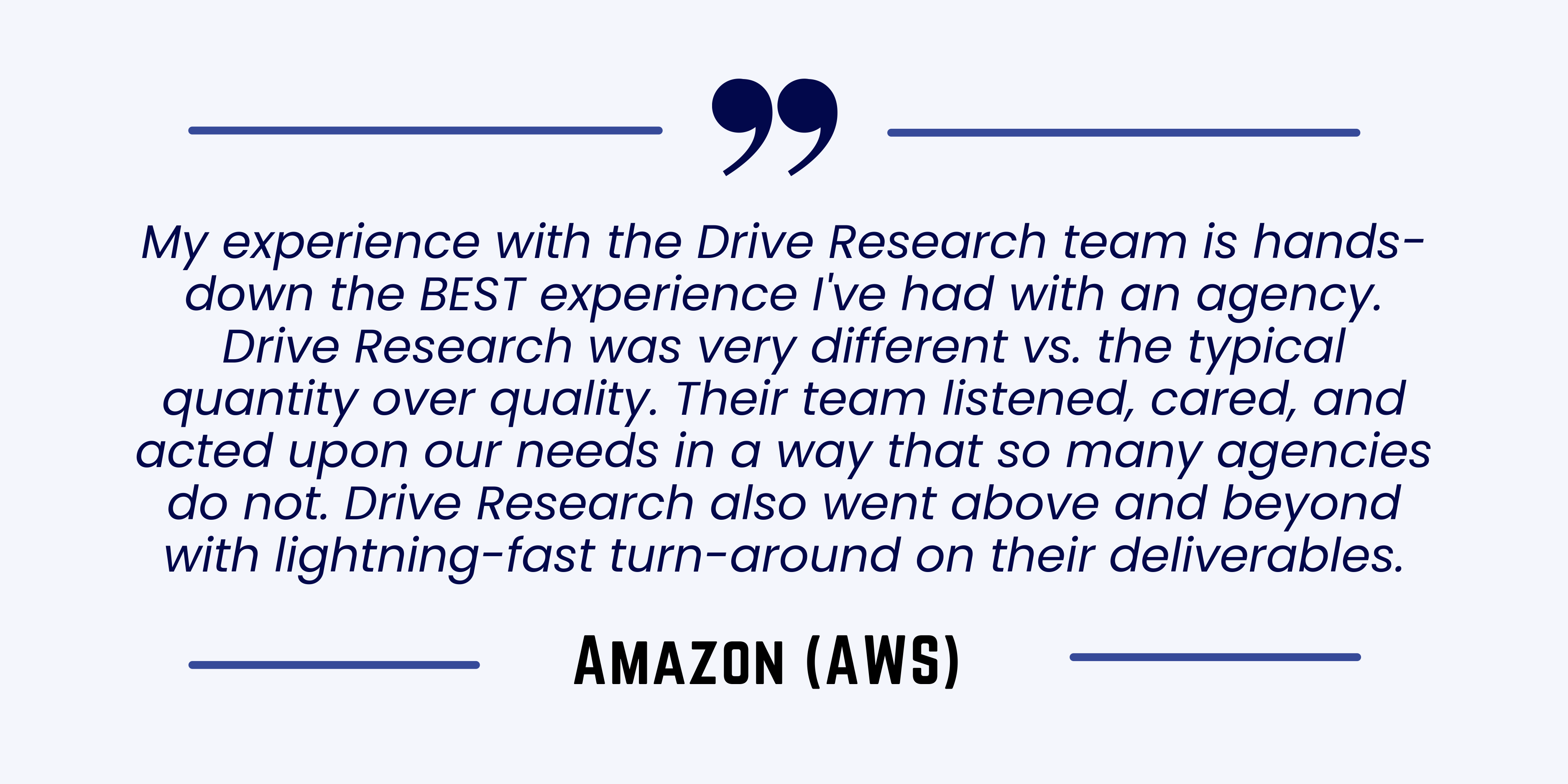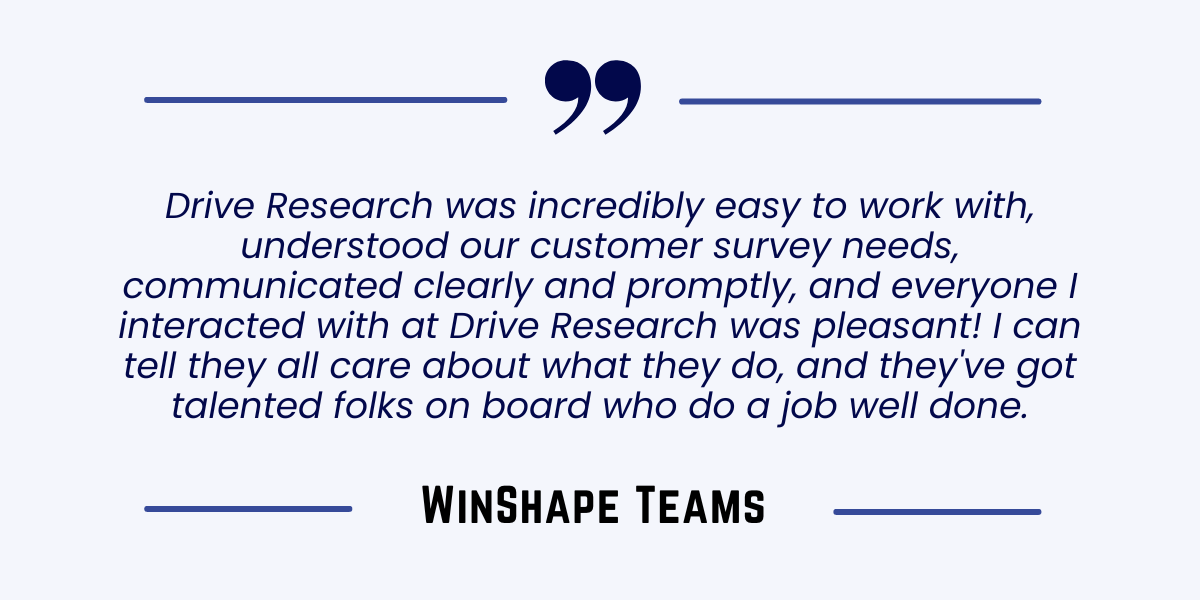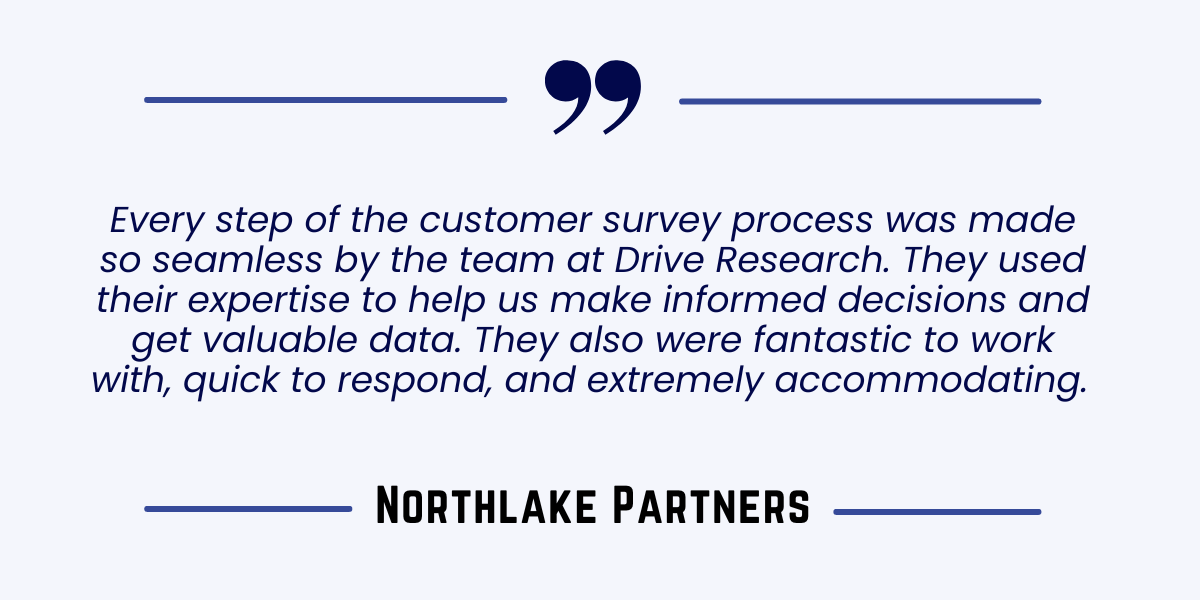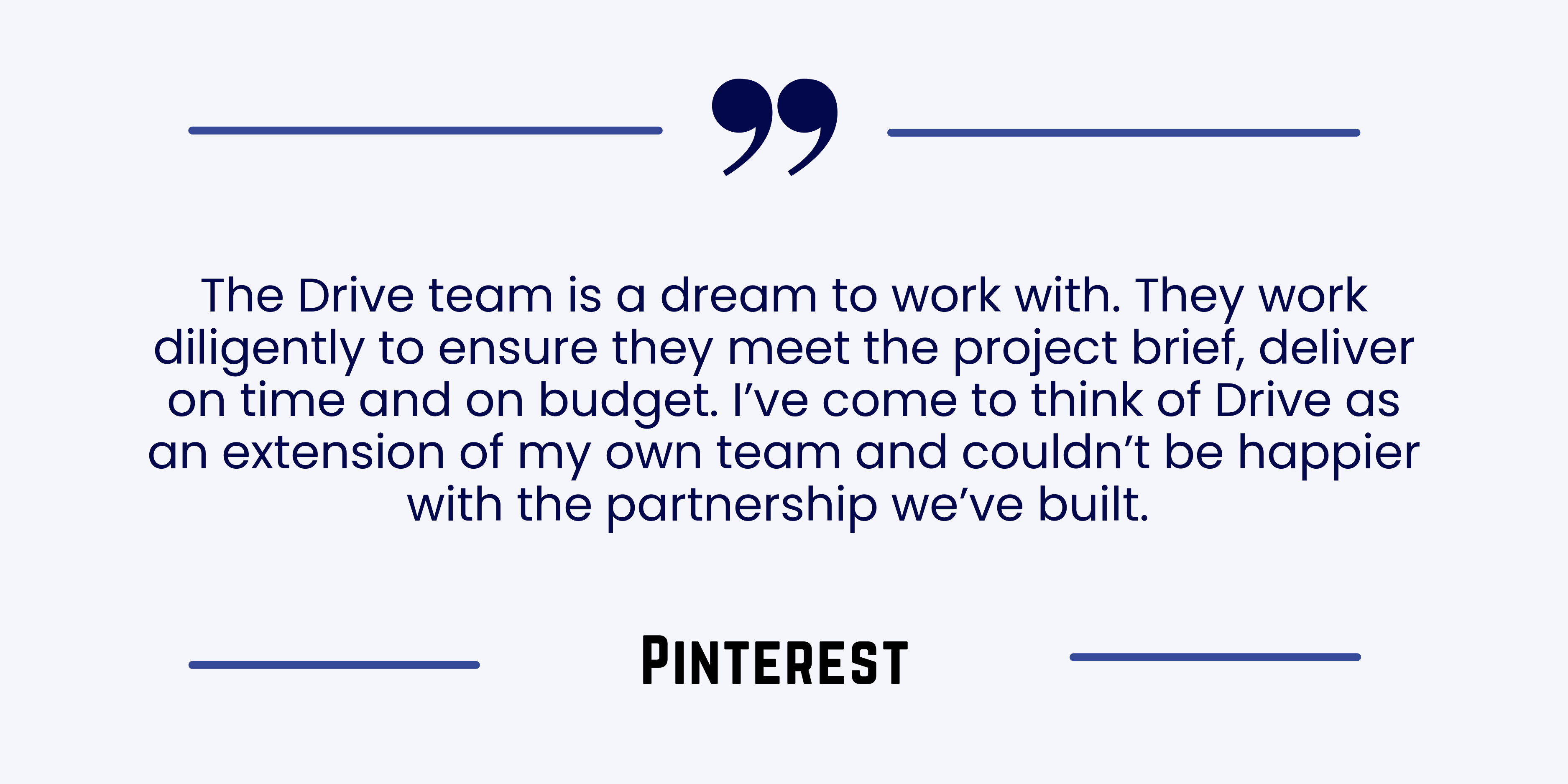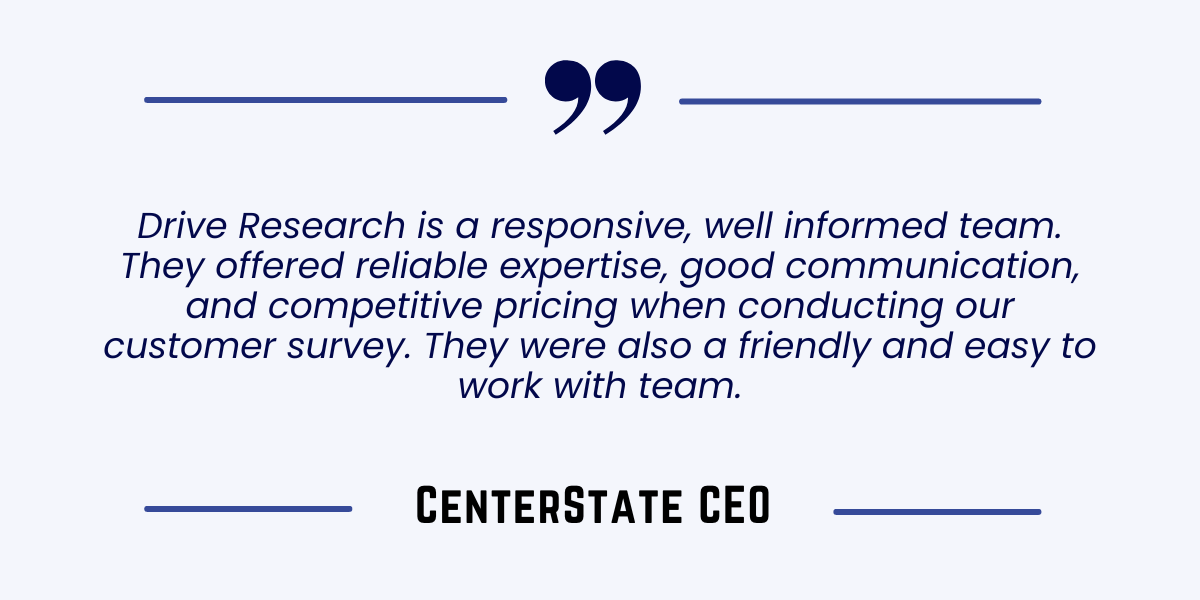At Drive Research we have a collective 80+ years of experience doing projects like pricing research. We’re highly experienced in all methodologies related to pricing research like surveys, conjoint studies, and more.
Not only have we worked on pricing research projects globally, but we’ve also conducted this type of research across many industries (B2B, B2C, e-commerce, Industrial, and more).
We have highly experienced data scientists and research analysts with the capabilities of a full-service custom research firm, which means we can design, field, execute, analyze, and report your pricing research for you to ensure accurate results that your organization will actually understand and be able to implement.
What Exactly Is Pricing Research?
Pricing research is a useful way to learn what current customers or prospects think of your pricing compared to competitors, how they may view a change in your pricing structure, or what levels of pricing they may tolerate in the market or in the context of their lives.
The data you get from a pricing research project should provide you with a relevant audience perspective to plan or change your pricing strategy.
Projects we see typically target direct feedback on current pricing, theoretical pricing research when exploring or planning for a change, and getting an idea for a market entry price model based on a product or service that remains in a development or pre-launch status.
When used correctly, pricing research can help a company adjust prices or even the product/service itself to reflect more advantageous pricing and offer structure in the market. Pricing research results can be applied to increase margins on a product, increase top-line sales, or save a product from being a total flop before launching.
Our Pricing Research Company Services
Pricing Surveys![]()
An online survey can be a great way to collect reliable data for pricing research quickly. You’ll need a complex approach for surveys to develop the right questions (for the best data). From writing the pricing survey questions to the data analysis and reporting at the end, we’ll do all of the heavy lifting for your pricing research survey.
Conjoint Analysis![]()
A conjoint analysis study can be conducted via many survey research platforms available today, either as a pre-built tool or a custom-built experimental design. It’s similar to the way we would run an online survey but with a much more directed and specific approach (specific to conjoint analysis type of questions and project setup).
Focus Groups and Interviews![]()
While less popular for pricing research, focus groups can bring a unique opportunity to collect in-depth data and explore pricing opportunities. It offers a more flexible approach for questions which can lead to more complex learnings and the discovery of new considerations. As a full-service research firm, we offer qualitative recruitment services in addition to custom focus groups and in-depth interview methods.
Pricing Research Should Be More In-Depth Than You Think
A lot of surface-level pricing research projects might include a simple ask to participants.
For example, “Would you buy this product? Yes or No”, does not cover the complexity behind pricing, and isn't a reflection of all the planning and work that goes into pricing strategy.
Better ways to approach pricing research include:
- Assigning value to the product or service before asking for feedback
- Asking about a range of prices for the product/service
- Follow up and dig deeper with research participants about why they would or would not consider or buy at certain prices
- Get initial reactions to the product, service, offer, and brand on features and attributes before pricing exploration
For the best results, it’s important to have a sophisticated approach to your project. Doing so will ensure you get high-quality data that can be used to make informed and profitable business decisions.
Conduct third-party pricing market research and earn quality, actionable data
Request a Quote
Pricing Models To Keep In Mind
Van Westendorp Pricing Model
The Van Westendorp model typically works by asking 4 main questions in an organized survey:
- At what price do you think the product is priced so low that it makes you question its quality?
- At what price do you think the product is a bargain?
- At what price do you think the product begins to seem expensive?
- At what price do you think the product is too expensive?
When writing your questions, you can leave each question open-ended and let the respondent write in the dollar value for each, or you can provide them with a range of price points. The options are to essentially apply open-ended versus closed-ended questions.
We recommend offering a range of price points for your survey respondents. The reason for this points to one of our early points in this post. When asked open-ended, respondents may write or type in unrealistic price points which then become outliers or unusable data.
Gabor Granger Pricing
The Gabor-Granger is a direct pricing technique that asks respondents about price ranges. During the project, researchers will continuously change the prices asked and then add follow-up questions for answers.
An example could be asking participants if they would purchase a product at a price then increasing the price by $5, $10, $15, $20, and asking again each time.
This method assumes that the audience already knows the value of a product and does not do any value assigning. With the results and data, the expected price demand can be calculated for the specific product or service.
One last thing to consider for Gabor-Granger is that it does not take competitive pricing into account.
Conjoint Analysis Pricing
Conjoint analysis can be an effective method for pricing research. It typically looks at both pricing and the product/service itself (to assign some sort of value to the audience). The most popular type of conjoint analysis is discrete choice.
The discrete choice version of conjoint analysis modeling gives respondents a choice of product configurations and asks them to choose one. Their decision can help point out ideal packaging and pricing models for customers.
How Pricing Market Research Can Help

There are a few hidden benefits to pricing research (like competitor analysis) that you might not have considered at first.
For example, it’s possible to compare all competitors and their pricing to your pricing or potential pricing. This can give a lot of valuable feedback if products/services are similar, or if you serve a similar target market as others.
It’s also great for financial planning for any company. Having a well-researched and reliable pricing strategy means that finances can be similarly organized since revenue and profits may be more predictable.
The biggest benefits you can get from a good pricing research project are:
- Direct feedback from customers and prospects before a decision or change in implemented in pricing
- Understanding of how customers may react to pricing changes, including changes in behaviors, perceptions, and emotions
- Projecting the financial or business impact of a pricing change or decision
- Learning the impact a pricing change may have on the product or service category, including competitive gains and loses
See Why Businesses Love Working with Drive Research
The portfolio of clients at our market research agency includes various types of B2B and B2C organizations across the world. We bring a level of importance to your project that we would bring to our own business. It is important to our team to manage both client and respondent expectations. It’s how we’ve earned a nearly perfect 5-star Google rating from both parties.
Contact Our Pricing Research Company
We at Drive Research work with your team to create a customized project that is complete, reliable, and effective. We work best with clients who understand their goals but are looking to have their research managed to utilize our experience and expertise.
Our pricing research company offers quality data, affordable projects, and fast results for your business. Your success is our success.

